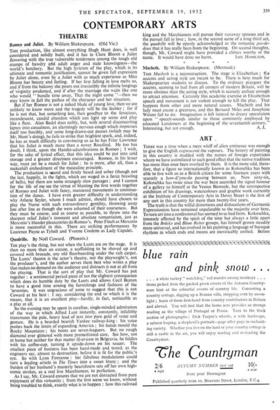ART ,
THERE was a time when a mere whiff of alien eminence was enough to give the English cognoscenti the vapours. The history of painting in this country is studded with the names of foreign expatriates whom we have assimilated to such good effect that the native tradition has more than once been overlaid by them. It is the more odd, there- fore, that a figure so internationally known as Kokoschka has been able to live with us as a British citizen for some fourteen years with scarcely a how-d'you-do passing between us. Now sixty-six, Kokoschka has twice since the war been accorded the signal honour of a gallery to himself at the Venice Biennale, but the retrospective exhibition of his drawings, watercolours and graphic work currently at the Institute of Contemporary Arts in Dover Street is the first of any sort in this country for more than twenty-five years.
The truth is that the wilful distortions and dislocations of Germanic Expressionism have remained unpalatable to the majority over here. To turn art into a confessional has seemed to us bad form. Kokoschka, intensely affected by the spirit of the time but always a little apart from the Briicke and Blaue Reiter groups, has himself grown steadily more universal, and has evolved in his painting a language of baroque rhythms in which ends and means are inextricably unified. Before 1914, however, his thinking was essentially linear and graphic, coloured more intensely by a sense of spiritual tragedy. This exhibi- tion shows him moving from the Jugendstil of his first prints to the strangely broken, disjointed line, the curving crosshatch, the radiating crows' feet, that reflect his own sense of crisis and Weltschmerz.
Three-dimensional form often disappears in the febrile agitation of the drawing surface, but that Kokoschka has a monumental grasp of form when he chooses to exercise it is shown by the splendid series of portrait heads. To the invisible emanations of personality he was —and is—as acutely sensitive as a geiger counter to radio-activity. Think of the portraitists of this century. There are not many, and Kokoschka is among-them. His real stature, however, will not be gauged here until we see a full exhibition of his painting.
To the New Burlington Galleries the Arts Council has brought the exhibition of pottery and textiles first arranged at Dattington Hall two months ago. I must confess to a prejudice against the crafts movement. Apart from the pleasure it gives to the practitioner, it has too often been vitiated by a mystique in which self-consciousness, a folksy mediaevalism, lost traditions of technique and an uncertain economic basis are all compounded. Much of the pottery in this exhibition, culled from the last thirty years, seemed to my eye clumsy in conception, lifeless in rhythtn, dull intlecoration and extraordinarily unadventurous. The three craftsmen most regularly capable of producing forms which spring to life, quicken the tactile sense and delight the eye seemed to me Bernard Leach, the conscience of modern pottery (further examples of his work may be seen at the Beaux Arts Gallery) ; Lucie Rie, refined and delicate • and James Tower, more than most aware of the present-day climate.
The textiles are another thing. Some of the printed fabrics by students show an unwonted zest, while the woven textiles, rich and sumptuous in a great variety of textures, show what we do best. Ethel Mairet must have special mention, and it is noteworthy that among younger designers the power-loom is not regarded with horror. It is surely one of the functions of craftsmen to enrich commercial industrial design with the results of their research.
- M. H. MIDDLETON.



































 Previous page
Previous page